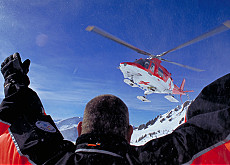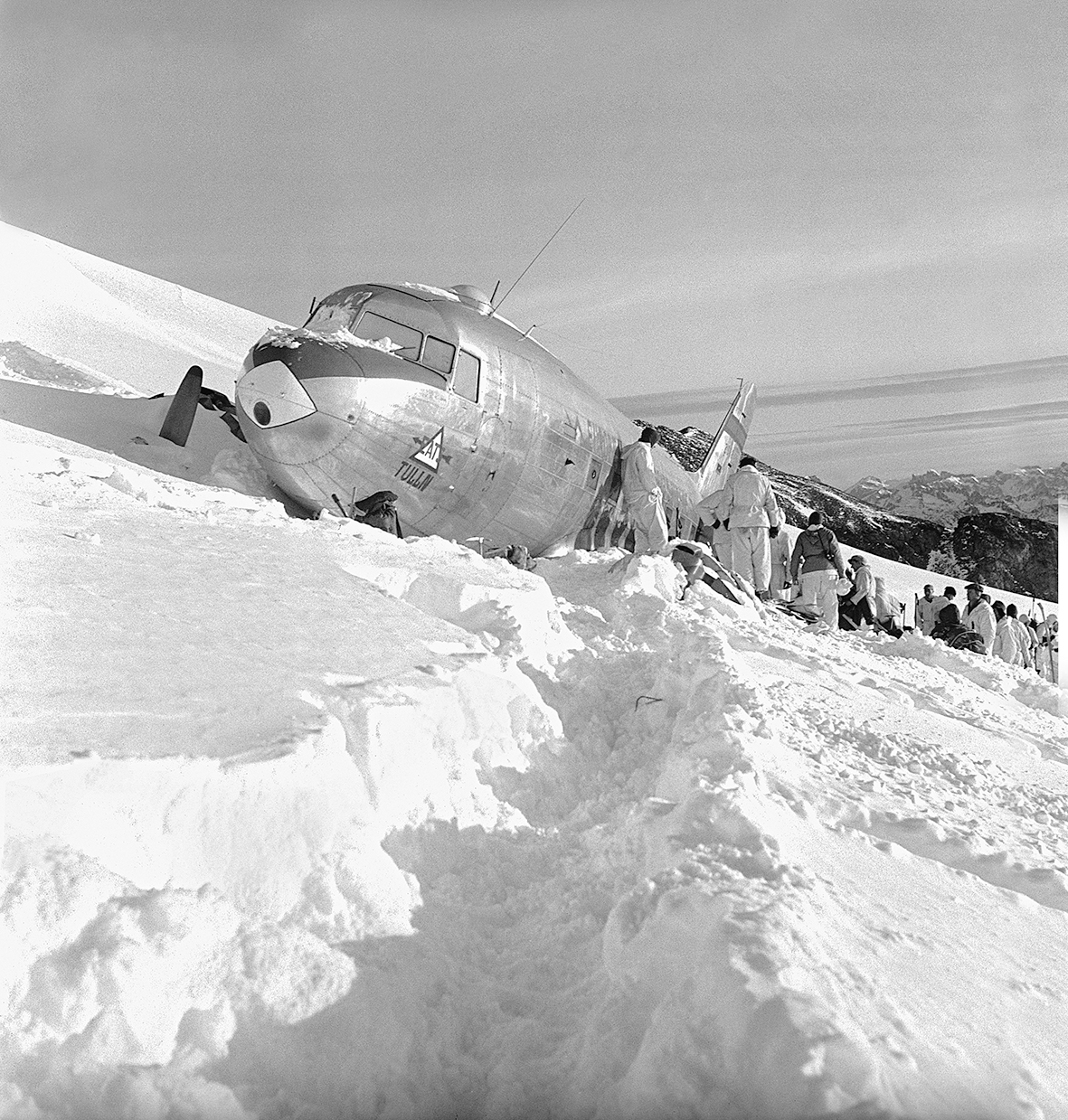Air rescue reaches new heights after 60 years

A bus crash that claimed the lives of 22 children in March stretched Swiss emergency services to the limit, including the air ambulance service. Its helicopters ferried some of the injured from the crash site in canton Valais to hospital.
All three of its jets were later in action repatriating the Belgian school pupils back home. This was one of the largest, and most traumatic, operations in the 60 year history of the Swiss Air Rescue Service (Rega).
A few weeks later, the air ambulance was active once again, this time in Turkey where 19 Swiss tourists were hurt in a bus crash – an accident that left another of their group dead.
A locally-based Rega doctor was on the scene within hours and 14 of the injured Swiss were returned home by the air ambulance service inside two days.
It was revealed this week that Rega also responds to requests from foreign armed forces to fly out sick and injured members. According to the Handelszeitung magazine, Rega carried out 17 repatriation flights of US soldiers from Irak and Afghanistan over the past two years.
Rega spokesman Sascha Hardegger confirmed to swissinfo.ch that this had included flights to the German town of Ramstein – where the United States Air Force has a major base.
“Such flights enhance our operational and medical know-how,” he said.
A number of Swiss politicians have criticized these repatriations under the Swiss red cross symbol which they say contravene principles of neutrality.
Last year was the busiest ever for Rega, with its 17 helicopters and three jet aircraft flying 14,240 missions at home and abroad to rescue its stricken citizens. It is little wonder that the non-profit service has earned iconic status, mentioned by many Swiss in the same breath as the Red Cross – of which Rega is a member organisation.
Gauli glacier crash
Rega was founded on April 27, 1952 at a meeting at the Hotel Bären in Twann on the shores of Lake Biel. In its first year of operating, the service flew just six missions – its helicopters alone flew five times that number every day last year.
But the idea of a Swiss air rescue service was born from the crash of a US military plane on the Gauli glacier, canton Bern, in 1946. Following a four-day search, two Swiss army aircraft were able to land on a nearby glacier to complete a dramatic rescue of the crew and passengers of the crashed US plane. (See gallery)
The rescue not only demonstrated the effectiveness of airborne rescue in the alps, but was also said to help repair Swiss-US post-war diplomatic relations.
Six years later, the Swiss Air Rescue Service was formally initiated as a sub-section of the Swiss Rescue Association under the leadership of Rudolf Bucher.
In its first few years, the service not only rescued people from the rugged terrain of the Swiss Alps, but also took part in international operations.
Parachutists, who had been trained by the British Royal Air Force, dropped into the Netherlands to help people trapped in a flood in 1953. The following year, Swiss rescuers were called into action after an avalanche in Austria.
International cooperation
In 1956, Rega flew to the US to assist in the recovery of bodies in the Grand Canyon following a mid-air collision between two commercial aircraft. Further operations in Turkey, Italy and Romania followed over the years.
“We are proud that the Rega name is held in such high regard around the world,” chief executive Ernst Kohler told swissinfo.ch. “Air rescue services around the world are now better equipped than before, but we still cooperate with other organisations with training and passing on our knowledge in areas such as night flights.”
Swiss tourists also have the comfort of travelling throughout the world knowing that Rega is on standby to fly them back home should they become ill or injured. (See video) The service arranged for 60 Swiss tourists to be repatriated after the Asian tsunami in 2004, but its operations overseas are gradually diminishing each year.
In 2011, Rega was involved in 2,114 medical emergencies abroad, a reduction of 19 per cent on the previous year.
“Medical services in many countries are much better than they were 20 years ago, so there is less medical need for repatriations,” Kohler told swissinfo.ch. “But people also want to be returned home for social reasons. It is more comforting to be treated in your home country when you are ill.”
Highly regarded service
The depth of Rega’s appeal is apparent in its 2.4 million patrons (86,000 more than 2010) who contributed SFr86.5 million ($94 million) in donations last year.
The figures take on more significance in a country with a population of eight million. So does the fact that the free Rega service is available to everyone regardless of whether they pay a donation or not.
The donations also enable Rega to conduct its operations without the need for public taxpayers’ money. But the implication that donators could expect a service in return for their money led to the country’s highest court in November upholding an earlier ruling that the income should be subject to value added tax (VAT).
Rega has complained that the SFr5.5 million VAT bill last year equates to the loss of 185,000 basic patron donations.
“The VAT charge really hurts us,” Kohler told swissinfo.ch. “It’s just not fair to take funds away from a non-profit organisation. This money should really be put to use flying planes and not just stashed into the state coffers.”
The debate has now escalated into the political arena and Kohler does not expect a final resolution any time soon. “A political ruling in our favour would be a nice [60th] birthday present, but getting laws changed is a long process,” he told swissinfo.ch.
Rega was formed on April 27, 1952 as a non-profit foundation.
In 1960, Rega broke away from the Swiss Rescue Association to become a fully independent operation, renamed the Swiss Air Rescue Association.
Five years later, the Swiss government approved Rega’s amalgamation into the Red Cross as an auxiliary service. In 1981 the Red Cross accepted Rega as a corporate member.
The Swiss government rejected an appeal for extra funding in 1966, leading to the creation of the patronage system which still runs today.
By 1985 the number of patrons had risen to one million, then two million in 2007, with the figure now at 2.4 million. In 2007, the Swiss public voted Rega as the country’s most respected brand in a corporate image poll.
1953: Parachutists are used for the first time as the Rega assists in an operation to rescue people trapped in a flood in the Netherlands.
1956: Swiss Air Rescue Service specialists are called to the Grand Canyon to retrieve bodies from a 1,200 metre deep ravine following a mid-air collision between two commercial aircraft.
1960: In France, the first repatriation of a Swiss patient is completed by Rega.
1977: Rega pilots achieve the impossible by rescuing two climbers from the acclivity on the North face of the Eiger.
1980: Another daring rescue is effected by freeing a parachutist who had become entangled in an aircraft. The mission was carried out while the aircraft was still flying.
1982: The “Rescue Chain” – comprising Rega, the Swiss Disaster Relief Unit, the Swiss Army Rescue Troops and the Swiss Disaster Dog Association – go into action for the first time in Yemen.
2004: The tsunami in southeast Asia is one of Rega’s greatest challenges so far. Teams go to Thailand and Sri Lanka and arrange for 60 patients to be flown back to Switzerland, attended to by 16 medical teams.
2005: Rega transports more than 200 people from flooded and cut-off areas during severe storms in Switzerland.

In compliance with the JTI standards
More: SWI swissinfo.ch certified by the Journalism Trust Initiative













You can find an overview of ongoing debates with our journalists here . Please join us!
If you want to start a conversation about a topic raised in this article or want to report factual errors, email us at english@swissinfo.ch.